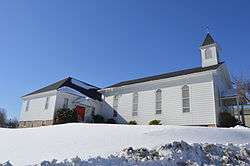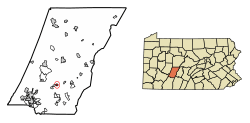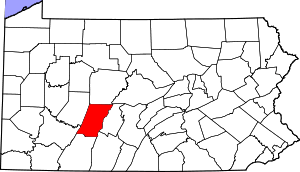Summerhill, Pennsylvania
Summerhill is a borough in Cambria County, Pennsylvania, United States. The population was 490 at the 2010 census.[3]
Summerhill, Pennsylvania | |
|---|---|
Borough | |
 St. John's Lutheran Church | |
 Location of Summerhill in Cambria County, Pennsylvania. | |
 Summerhill Location of Summerhill in Cambria County, Pennsylvania. | |
| Coordinates: 40°22′32″N 78°45′38″W | |
| Country | United States |
| State | Pennsylvania |
| County | Cambria |
| Settled | 1810 |
| Incorporated | 1892 |
| Government | |
| • Type | Borough council |
| Area | |
| • Total | 0.33 sq mi (0.86 km2) |
| • Land | 0.33 sq mi (0.85 km2) |
| • Water | 0.01 sq mi (0.01 km2) |
| Elevation | 1,594 ft (486 m) |
| Population (2010) | |
| • Total | 490 |
| • Estimate (2019)[2] | 444 |
| • Density | 1,353.66/sq mi (522.79/km2) |
| Time zone | UTC-5 (Eastern (EST)) |
| • Summer (DST) | UTC-4 (EDT) |
| ZIP code | 15958 |
| Area code(s) | 814 |
| FIPS code | 42-75136 |
History
Summerhill, a small borough in the Allegheny Mountains in southwestern Pennsylvania, was settled in the early 1800s and grew in large part from the Allegheny Portage Railroad and the Pennsylvania Railroad.
The Thomas and Barbara Croyle family was one of the earliest recorded families to settle in the town in 1794. Their family homestead, a two-story stone structure that still stands, served the family as a fortress against Indian attacks. According to some sources, Indians burned the Croyles' cabin and property, causing the family to seek refuge at Fort Bedford. By 1800, Barbara Croyle chose to rebuild their homestead with stone; she limited windows to two sides of the house to keep it stronger if attacked.[4][5]
The Croyle family built a grist mill, known locally as Croyle's Mill, and a dam on the Little Conemaugh River to operate it. The establishment of the mill was significant enough for the county to notice and fund its first public works project, a dirt road from Ebensburg to Croyle's Mill. The mill operated into the 1900s.[4]
In February 1810, Summerhill Township was devolved from larger Conemaugh Township, one of three original townships established in Cambria County. Originally spelled "Somerhill", the township was likely named for Joseph and David Somers, some of its early, chief landowners.[4]
In the 1820s, Summerhill Township covered a large swath of land in the north-central part of the current county, including present-day Jackson, Munster, Washington, Portage and Blacklick townships. The existing borough took its name from Summerhill Township and was then known as Summer Hill. Records from 1926 indicate the borough's current spelling, Summerhill.[4]
Geography
Summerhill is located in south-central Cambria County at 40°22′32″N 78°45′38″W (40.375424, -78.760623)[6] in the Laurel Highlands of the Allegheny Mountains. The north branch of the Little Conemaugh River and Laurel Run, tributaries of the Conemaugh River, run through the community. Summerhill is bordered on the west by the borough of Ehrenfeld.
U.S. Route 219, a four-lane expressway, runs through the northwest part of the borough, with access from an interchange with Pennsylvania Route 53 southwest of the borough limits. US 219 leads north 10 miles (16 km) to Ebensburg, the county seat. Johnstown is 14 miles (23 km) to the southwest via US 219 and Pennsylvania Route 56.
According to the United States Census Bureau, Summerhill borough has a total area of 0.33 square miles (0.86 km2), of which 0.33 square miles (0.85 km2) is land and 0.004 square miles (0.01 km2), or 1.53%, is water.[3]
Demographics
| Historical population | |||
|---|---|---|---|
| Census | Pop. | %± | |
| 1880 | 343 | — | |
| 1900 | 591 | — | |
| 1910 | 863 | 46.0% | |
| 1920 | 890 | 3.1% | |
| 1930 | 785 | −11.8% | |
| 1940 | 861 | 9.7% | |
| 1950 | 849 | −1.4% | |
| 1960 | 870 | 2.5% | |
| 1970 | 726 | −16.6% | |
| 1980 | 725 | −0.1% | |
| 1990 | 614 | −15.3% | |
| 2000 | 521 | −15.1% | |
| 2010 | 490 | −6.0% | |
| Est. 2019 | 444 | [2] | −9.4% |
| Sources:[7][8][9] | |||
As of the census[8] of 2000, there were 521 people, 220 households, and 146 families residing in the borough. The population density was 1,647.5 people per square mile (628.6/km²). There were 227 housing units at an average density of 717.8 per square mile (273.9/km²). The racial makeup of the borough was 99.81% White and 0.19% Asian. Hispanic or Latino of any race were 0.58% of the population.
There were 220 households, out of which 27.7% had children under the age of 18 living with them, 55.5% were married couples living together, 10.9% had a female householder with no husband present, and 33.2% were non-families. 32.7% of all households were made up of individuals, and 20.5% had someone living alone who was 65 years of age or older. The average household size was 2.36 and the average family size was 3.00.
In the borough the population was spread out, with 25.7% under the age of 18, 8.3% from 18 to 24, 25.1% from 25 to 44, 20.3% from 45 to 64, and 20.5% who were 65 years of age or older. The median age was 38 years. For every 100 females there were 86.1 males. For every 100 females age 18 and over, there were 76.7 males.
References
- "2019 U.S. Gazetteer Files". United States Census Bureau. Retrieved July 28, 2020.
- "Population and Housing Unit Estimates". United States Census Bureau. May 24, 2020. Retrieved May 27, 2020.
- "Geographic Identifiers: 2010 Demographic Profile Data (G001): Summerhill borough, Pennsylvania". U.S. Census Bureau, American Factfinder. Archived from the original on March 19, 2015. Retrieved March 19, 2015.
- Alcamo, Frank P. (1992). The Summerhill Story: The 1992 Centennial. Indiana, PA: The A.G. Halladin Publishing Co., Inc.
- "Cambria County Historical Society". Cambria County Heritage. Volume 22, Issue 2. May 2002. Retrieved February 19, 2013.
- "US Gazetteer files: 2010, 2000, and 1990". United States Census Bureau. 2011-02-12. Retrieved 2011-04-23.
- "Census of Population and Housing". U.S. Census Bureau. Retrieved 11 December 2013.
- "U.S. Census website". United States Census Bureau. Retrieved 2008-01-31.
- "Incorporated Places and Minor Civil Divisions Datasets: Subcounty Resident Population Estimates: April 1, 2010 to July 1, 2012". Population Estimates. U.S. Census Bureau. Archived from the original on 17 June 2013. Retrieved 11 December 2013.
